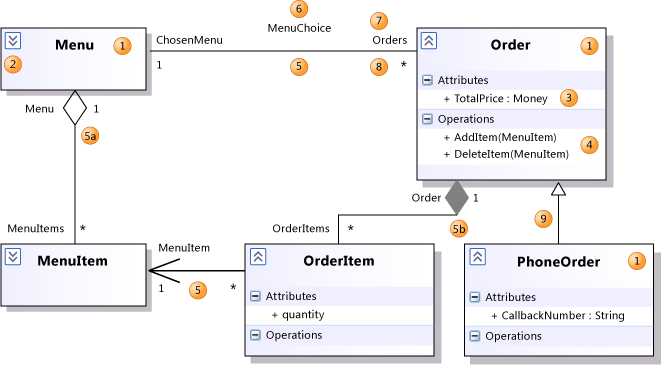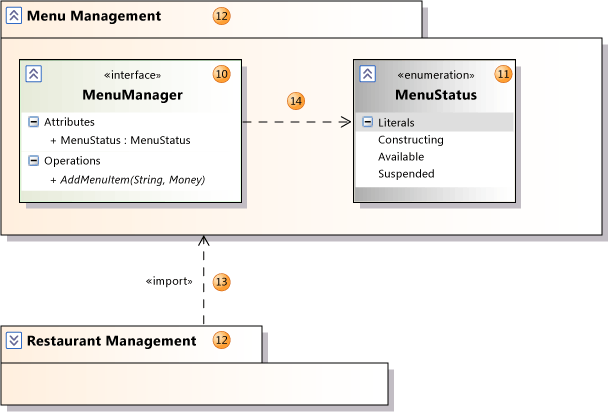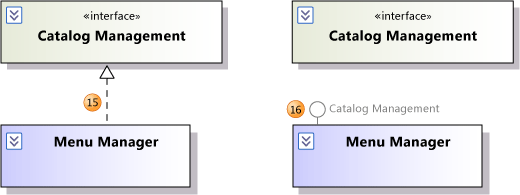What is a great way to learn good UML design? How often do you draw diagrams (other than static diagram of classes)? What is the best source for learning it?
The best source for learning UML?
uml
Related Solutions
Robustness diagrams are written after use cases and before class diagrams. They help to identify the roles of use case steps. You can use them to ensure your use cases are sufficiently robust to represent usage requirements for the system you're building.
They involve:
- Actors
- Use Cases
- Entities
- Boundaries
- Controls
Whereas the Model-View-Controller pattern is used for user interfaces, the Entity-Control-Boundary Pattern (ECB) is used for systems. The following aspects of ECB can be likened to an abstract version of MVC, if that's helpful:

Entities (model)
Objects representing system data, often from the domain model.
Boundaries (view/service collaborator)
Objects that interface with system actors (e.g. a user or external service). Windows, screens and menus are examples of boundaries that interface with users.
Controls (controller)
Objects that mediate between boundaries and entities. These serve as the glue between boundary elements and entity elements, implementing the logic required to manage the various elements and their interactions. It is important to understand that you may decide to implement controllers within your design as something other than objects – many controllers are simple enough to be implemented as a method of an entity or boundary class for example.
Four rules apply to their communication:
- Actors can only talk to boundary objects.
- Boundary objects can only talk to controllers and actors.
- Entity objects can only talk to controllers.
- Controllers can talk to boundary objects and entity objects, and to other controllers, but not to actors
Communication allowed:
Entity Boundary Control
Entity X X
Boundary X
Control X X X
Here's some explanations from the Visual Studio 2015 docs:
UML Class Diagrams: Reference: https://docs.microsoft.com/en-us/previous-versions/visualstudio/visual-studio-2015/modeling/uml-class-diagrams-reference

5: Association: A relationship between the members of two classifiers.
5a: Aggregation: An association representing a shared ownership relationship. The Aggregation property of the owner role is set to Shared.
5b: Composition: An association representing a whole-part relationship. The Aggregation property of the owner role is set to Composite.
9: Generalization: The specific classifier inherits part of its definition from the general classifier. The general classifier is at the arrow end of the connector. Attributes, associations, and operations are inherited by the specific classifier. Use the Inheritance tool to create a generalization between two classifiers.

13: Import: A relationship between packages, indicating that one package includes all the definitions of another.
14: Dependency: The definition or implementation of the dependent classifier might change if the classifier at the arrowhead end is changed.

15: Realization: The class implements the operations and attributes defined by the interface. Use the Inheritance tool to create a realization between a class and an interface.
16: Realization: An alternative presentation of the same relationship. The label on the lollipop symbol identifies the interface.
UML Class Diagrams: Guidelines: http://msdn.microsoft.com/library/dd409416%28VS.140%29.aspx
Properties of an Association
Aggregation: This appears as a diamond shape at one end of the connector. You can use it to indicate that instances at the aggregating role own or contain instances of the other.
Is Navigable: If true for only one role, an arrow appears in the navigable direction. You can use this to indicate navigability of links and database relations in the software.
Generalization: Generalization means that the specializing or derived type inherits attributes, operations, and associations of the general or base type. The general type appears at the arrowhead end of the relationship.
Realization: Realization means that a class implements the attributes and operations specified by the interface. The interface is at the arrow end of the connector.
Let me know if you have more questions.
Best Answer
I think Martin Fowler's "UML Distilled" is the best book for learning UML syntax. It's succinct and dense with information.
Unfortunately, knowing UML syntax well is not the same thing as knowing how to design.